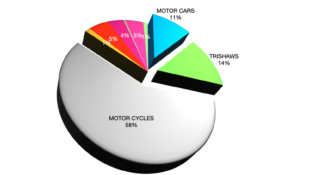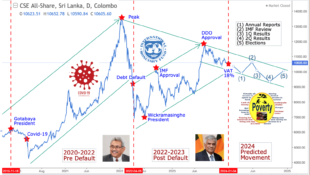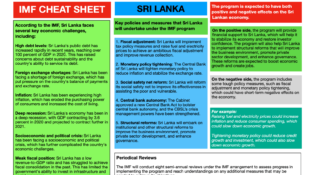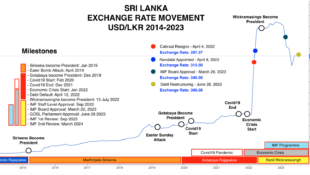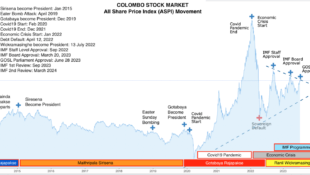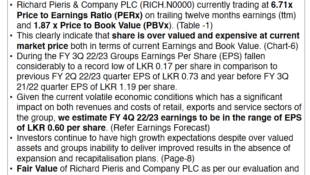ER Dips To Rs. 120 Before Settling at Rs. 119/70/90 Levels
The exchange rate (ER) on the back of importer demand and speculation depreciated by 50 cents to Rs. 120 to the US dollar ($) on Friday over that of the previous day Thursday’s close, before recovering to be quoted at the Rs. 119/70/90 levels in two way quotes in interbank trading by the weekend, a market source told this reporter.
On the previous day too, ie on Thursday (February 23), importer demand held sway in the market, resulting in the ER being lowered by as much as 70 cents to Rs. 119/40/50 in two way quotes.
However on Wednesday (February 22), the ER was bereft of the volatility it experienced in the immediate aftermath of the rupee free float, with the ER depreciating by 20 cents each in the first two days of last week to be commanding prices in the region of Rs. 118.70/80 to the $ in two way quotes in interbank trading as at Wednesday.
Monday was a bank holiday.
The source expected pressure on the ER to continue in the new week beginning tomorrow as well, despite the fact that the GoSL delivered a further kidney punch on the poor man’s stomach by increasing bread prices by Rs. 5 due to agitation by bakers and an expected Rs. 15 increase in milk powder prices due to demands by milk powder manufacturers.
A weak rupee makes the cost of essential imported commodities such as medicines, sugar, wheat flour (and therewith bread) and milk powder to go up, hitting the poor the hardest.
A depreciating rupee may also force the poor to give up on essentials due to the higher prices those fetch, which needless to say have to be imported, leading to political instability in Sri Lanka as a result.
“Micro inflows of some $ 10-20 million, such as that which is being experienced in the stockmarket currently are not enough to obviate pressure on the ER,” another source said. Despite the end of the country’s 26 year old terrorist war, Sri Lanka is not getting large infusions of inflows as it should have had.
“We need massive inflows in the region of $ 2-3 billion to help alleviate the situation,” the source said.
Higher inflows, either in the form of foreign direct investments (FDI), grant or concessional aid or increased export revenue or tourism or remittances receipts would help alleviate pressure on the ER, caused primarily due to a rising import bill, aided and abetted by escalating oil prices globally due to the Iranian crisis.
A hotelier commenting on the situation said that the war end presented a golden opportunity to President Mahinda Rajapaksa to take the country forward. He has however missed the bus (see the business pages of The Sunday Leader’s last week issue).
Rajapaksa’s recently passed Expropriations Act which empowers the Government to takeover even public quoted companies, is no fillip to encourage either FDI or local investments into the country.
These columns last week predicted that the ER would settle at the level of between Rs. 118-119, which however was not to be.
In the immediate aftermath of the free float, the ER depreciated by as much as Rs. 2 or more on a daily basis, and Thursday’s and Friday’s sharp depreciations of the rupee by as much as Rs. 1.20 in total has had thrown that prediction overboard.
The lowest the ER has depreciated since the Government of Sri Lanka (GoSL)/Central Bank of Sri Lanka (CBSL) allowed for the free float of the rupee on February 9 was on February 15, when it fell to the Rs. 121 levels, after which it recovered due to alleged temporary intervention by CBSL then.
The source further said that forward bookings by both importers and exporters alike saw the ER’s forward premiums of one month and three months bookings go up to Rs. 4/4.30 and Rs. 2/2/30 respectively in two way quotes on Friday.
In contrast, just two days earlier, ie on Wednesday (February 22), one and three month forward bookings were going at premiums as low as 55 cents and Rs. 1.75 respectively.
In the previous week, those premiums fetched Rs. 1.75 and Rs. 3.70 respectively.
Importers who previously booked forward at any price after the rupee float due to panic are now subdued, a source, two days earlier, ie on Wednesday had however said. This has caused rupee volatility to settle, the source then had added. However exporters are still cautious to book forward which may not be good to assure for the sustainable stability of the local currency, he had then said, a prediction which, at least partially was proven to be true as the unfolding events the following day Thursday and Friday proved, despite exporters having had reenterd the forwards market on Friday.
Rates To Rise
Despite the volatility in the ER market in the last two days of the week, ie on Thursday and Friday, interest rates, without rising appreciably, held on tenuously, but Wednesday’s (February 22), Treasury Bill auction saw the weighted average yields (WAYs) for all three tenures on offer go up by a uniformed 20 basis points (bps) each, which a source however said that such symmetrical increases “smack” on the side of manipulation. As a result, three months (91 day), six months (182 day) and one year (364 day) T Bill maturities that came up for reissue on that day fetched WAYs of 9.51%, 9.64% and 10.19% respectively.
“There is room for yields to go up further”, he said. These pages in its last week’s edition predicted that yields in the T Bill auction in question will go up.
When asked whether such increases were due to the illiquid state of the market? The source answered in the affirmative. When asked whether such increases will have an impact on the market? He answered “yes,” while at the same time saying that the CBSL is following the market!
The market, sometime ago raised its fixed deposit rates to 12-12½% to attract liquidity which is under pressure due to credit growth, it’s only now that CBSL is adjusting itself to market rates, otherwise it will not be attractive for investors to invest in “low yielding” Government debt,* he said.
Normally it’s CBSL which is the trend setter, but here it’s the other way around, the source said.
He further said that with CBSL’s T Bill holdings spilling over to the Rs. 200 billion level, an indication as to how much of money was printed to meet both the Government’s and the market’s borrowing requirements, it was therefore imperative that the market be a conduit to attract massive inflows, in the range of $ 2-3 billion, to tide over this situation.
Micro inflows of some $ 10-20 million, such as that which is being experienced in the stockmarket currently are not enough, he said.
However an exercise of money printing to tide over the market’s illiquid state may cause further inflationary pressure on the economy.
But liquidity caused as a result of foreign inflows not only eases pressure on the ER, but is also a spur to international trade, further enriching the lives of those people in that country, while at the same time excess liquidity caused by that former exercise of money printing, may be drained off from the system by CBSL selling its excess stock of T Bills to the market, thereby controlling inflationary pressure on the economy caused by those forex inflows, by having a rein on rupee liquidity.
Currently what is happening is that CBSL, other than the market is also subscribing to T Bills offered, to negate the higher yields demanded by the latter, but on the flip side this exercise is fuelling inflationary pressure on the economy due to the excess money created by such an exercise.
* Investing in T bills is one form of investing in Government debt, to meet the state’s borrowing requirements.
http://www.thesundayleader.lk/2012/02/26/us-2-3-billion-inflows-needed-to-bring-stability/
 would enable you to enjoy an array of other services such as Member Rankings, User Groups, Own Posts & Profile, Exclusive Research, Live Chat Box etc..
would enable you to enjoy an array of other services such as Member Rankings, User Groups, Own Posts & Profile, Exclusive Research, Live Chat Box etc.. 
 Home
Home









